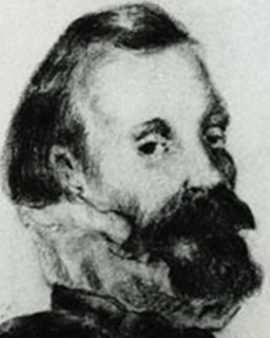Hendrick Avercamp was a Dutch landscape painter. He was born in Amsterdam, but the family moved to Kampen shortly after his birth. He received the nickname of the mute of Kampen. It is believed that Avercamp was deaf from birth and therefore never learned to speak properly. But already at a young age it became obvious that Avercamp is very good at printing himself in pictures. His parents hired an art teacher for the twelve-year-old. But since the teacher died of the plague at a very early age, the training was only of short duration. At the age of 18 Avercamp finally moved back to Amsterdam. He began an apprenticeship with the Danish painter Pieter Isaacks. Other influencers were probably David Vinckboons, Pieter Bruegel der Ältere and Gillis van Coninxloo. After finishing his apprenticeship, Avercamp returned to Kampen and probably never left the town again, except for some small trips to Amsterdam.
Avercamp was one of the first Dutch landscape painters to specialise almost exclusively in winter landscapes. He often chose an atmospheric perspective so that the viewer has a wide view of the scenery. The paintings were colourful and detailed. The fascination for this scenery can probably be traced back to two triggers. On the one hand, Avercamp was born in a time that fell during the last quarter of the so-called Little Ice Age. So the years of his youth were marked by long and especially cold winters. On the other hand, this circumstance is said to have led Avercamp to take frequent trips with his parents to go skating in his childhood. This memory must have been firmly anchored in his mind, because many of his winter landscapes, such as Ice Fun, show exactly this kind of scenes. Avercamp's works showed everyday scenes in nature with a certain folkloric charm. Often, on closer inspection, the pictures tell countless smaller stories. This circumstance caused the popularity, even beyond the borders of the country and brought him good sales, because they met the taste of the broad population.
For many of his pictures Avercamp went out into nature in winter and made countless sketches. These then served him in his studio as the basis for his paintings. In total Avercamp is said to have created around 100 works. Avercamp had several students during his career, for example his nephew Barent Avercamp or Arent Arentsz. But none of them succeeded him stylistically. Although Avercamp liked to paint large, lively crowds, he himself lived a very secluded life. It is not known whether this was due to the circumstance of his disability, which was documented more often. However, his mother apparently always felt pity and concern for her son and even had it stated in her will that Hendrick, unlike his brothers, was to receive an annual allowance of 100 gulden in addition to his share of the inheritance. However, Hendrick Avercamp ultimately died only 5 months after his mother.
×





.jpg)
.jpg)
.jpg)
.jpg)
.jpg)
.jpg)
.jpg)
.jpg)
.jpg)
.jpg)
.jpg)
.jpg)
.jpg)
.jpg)
.jpg)
.jpg)
.jpg)
.jpg)
.jpg)
.jpg)
.jpg)
.jpg)
.jpg)
.jpg)
.jpg)
.jpg)
.jpg)
.jpg)
.jpg)
.jpg)
.jpg)
.jpg)
.jpg)
.jpg)
.jpg)
.jpg)
.jpg)
.jpg)
.jpg)
.jpg)
.jpg)
.jpg)
.jpg)
.jpg)
.jpg)
.jpg)
.jpg)
.jpg)
.jpg)
.jpg)
.jpg)
.jpg)
.jpg)
.jpg)
.jpg)
.jpg)
.jpg)
.jpg)
.jpg)
.jpg)
.jpg)
.jpg)
.jpg)
.jpg)
.jpg)
.jpg)
.jpg)
.jpg)
.jpg)
.jpg)
.jpg)
.jpg)
.jpg)
.jpg)
_-_(MeisterDrucke-414434).jpg)
_-_(MeisterDrucke-414434).jpg)
.jpg)
.jpg)
.jpg)
.jpg)
.jpg)
.jpg)
.jpg)
.jpg)
.jpg)
.jpg)
.jpg)
.jpg)
.jpg)
.jpg)
.jpg)
.jpg)
.jpg)
.jpg)
.jpg)
.jpg)
.jpg)
.jpg)
_-_(MeisterDrucke-569042).jpg)
_-_(MeisterDrucke-569042).jpg)
.jpg)
.jpg)
.jpg)
.jpg)
.jpg)
.jpg)
.jpg)
.jpg)
.jpg)
.jpg)
.jpg)
.jpg)
.jpg)
.jpg)
.jpg)
.jpg)
 - (MeisterDrucke-99312).jpg)
 - (MeisterDrucke-99312).jpg)
.jpg)
.jpg)
.jpg)
.jpg)
.jpg)
.jpg)
.jpg)
.jpg)
.jpg)
.jpg)
.jpg)
.jpg)
.jpg)
.jpg)
.jpg)
.jpg)
.jpg)
.jpg)
.jpg)
.jpg)
.jpg)
.jpg)
.jpg)
.jpg)
.jpg)
.jpg)
.jpg)
.jpg)
.jpg)
.jpg)
.jpg)
.jpg)
.jpg)
.jpg)
.jpg)
.jpg)
.jpg)
.jpg)
.jpg)
.jpg)
.jpg)
.jpg)
.jpg)
.jpg)
.jpg)
.jpg)
.jpg)
.jpg)
.jpg)
.jpg)
.jpg)
.jpg)
.jpg)
.jpg)
.jpg)
.jpg)
.jpg)
.jpg)
.jpg)
.jpg)
.jpg)
.jpg)






